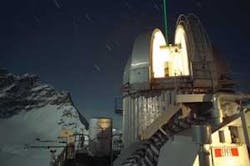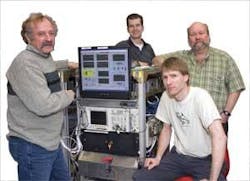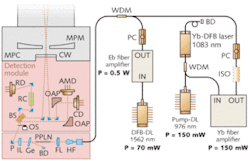PHOTONICS APPLIED: ATMOSPHERIC MONITORING: New photonic devices boost environmental monitoring capabilities
The ability to monitor weather events, detect harmful airborne contaminants, and quantify air pollution and greenhouse gases falls under the umbrella of atmospheric or environmental monitoring.
While the core measurement principles for popular optical absorption and emission techniques such as spectroscopy and light detection and ranging (LIDAR) have changed little over the years, the sources, detectors, and optoelectronic components within these systems have advanced dramatically–improving measurement accuracy, lowering detection thresholds, and making real-time measurements possible.
Just three years ago, for example, identification of many trace elements that lacked a definable “fingerprint” in the visible wavelength region (accessible in terms of available sources and detectors) was extremely difficult; however, many gases and atmospheric contaminants are now easily identified by their distinct mid-infrared (IR) signature, thanks to the availability of low-cost, rugged, compact mid-IR sources (see www.laserfocusworld.com/articles/259939). For example, a 9.5 µm quantum-cascade laser source from Daylight Solutions (Poway, CA) enables detection of chemical explosives at distances up to 20 m away using photoacoustic spectroscopy (see www.laserfocusworld.com/articles/338723).
Industrial and chemical agents
Environmental monitoring applications span the gamut, from chemical explosives and biological weapons detection in a localized area, to quantification of the potential carcinogenity of polycyclic aromatic hydrocarbons produced by wood fires or cigarette smoke, to detection of harmful gases and underground fires in coal mines.
Although many explosive chemicals have a strong spectral signature in the mid-IR region (3–12 µm), many more have definable signatures in the terahertz region (approximately 30–3000 µm). Companies like TeraView (Cambridge, England), Goodrich ISR Systems (Charlotte, NC), and Picometrix (Ann Arbor, MI) are commercializing terahertz spectroscopy instruments for the pharmaceutical industry for drug identification and quality monitoring, and for the defense industry for chemical detection. Goodrich ISR Systems has developed next-generation terahertz spectrometers to sniff out explosives and other toxic agents (see www.laserfocusworld.com/articles/323055). And TeraView was just selected to supply its continuous-wave terahertz technology to Goodrich for a terahertz spectrometer it is developing with the U.S. Department of Homeland Security for detection of chemical warfare agents.
While toxic chemicals in lethal concentrations are an obvious risk, many chemicals in lower concentrations (more difficult to detect) represent a longer-term health problem. Research from the Université du Littoral Cô te d’Opale (Dunkerque, France) established that a broadband submillimeter terahertz source used in a time-domain terahertz spectroscopy setup enabled fast, simultaneous detection of hydrogen cyanide (HCN), carbon monoxide (CO), and traces of formaldehyde (H2CO) in cigarette smoke at levels not easily detected using chemical analytical methods.1
Acidic gases such as oxides of nitrogen (NOx) and sulfur oxides (SOx) caused by blasting operations in open-pit coal mines also pose a health risk. Researchers at CSIRO Energy Technology (Newcastle, NSW, Australia) are measuring these gas emissions by scanning the resulting plumes from an open-cut mine blast with a miniaturized ultraviolet (UV) spectrometer from Resonance (Barrie, ON, Canada).2 The open-path spectroscopic method measured nitrogen dioxide (NO2) levels from 0 to 17 ppm.
Air pollution and greenhouse gases
While the CSIRO UV spectroscopy system can detect part-per-million NO2 concentrations in mine-blasting plumes, the technique is not sensitive enough to detect the part-per-trillion levels of NO2 occurring in the atmosphere. But researchers at the University of California, Berkeley, have developed and field-tested a compact system for laser-induced fluorescence (LIF)-based detection of atmospheric NO2 with a sensitivity of 145 parts per trillion (ppt) by volume per minute and a signal-to-noise ratio (S/N) of 2. Project researcher and director of the Berkeley Atmospheric Sciences Center, Ronald C. Cohen, says the low-cost, compact (18 kg, 0.5 m3) device uses a simple optical setup and a commercial continuous-wave (CW) 408 nm laser diode.
“NO2–a major contributor to ozone and aerosol formation, causing respiratory and other health issues–is a mixed story,” says Cohen. “There are significant decreases in the U.S. and Europe associated with using catalytic converters on cars and implementing controls at coal-fired power plants, but there are major increases in China. We are able to detect NO2 in real time by pumping an air sample through our detector. Older technologies based on catalytic conversion of NO2 to NO and then detection of NO by chemiluminescent reaction with O3 are widely used, but suffer from a large positive interference because other nitrogen oxides are also converted.” Cohen notes that in addition to LIF, there are several contenders for new technologies, including methods based on cavity ring down and other related absorption spectroscopies.
Another photonic technology, photon counting, is being used by researchers at the National Center for Atmospheric Research (NCAR; Boulder, CO) to measure oxidized species of nitrogen. “Our instrument combines trace-gas reactants from a continuous air sample along with the reagent into a reaction vessel carefully coupled to a cryogenically cooled PMT,” says David Knapp from the Community Airborne Research Instrumentation group (CARI) at NCAR. “This technique exploits the reaction NO + O3 = NO2 + O2 + hv, allowing us to measure mixing ratios of trace nitrogen compounds to tens of parts-per-trillion. The 390 nm UV light breaks the NO2 into NO and O which then travels to the reaction vessel to be detected as NO. We measure the photolysis efficiency such that we can then calculate the amount of NO2 in the sample stream.” The technique, says Knapp, provides a low detection limit, along with data acquisition rates as fast 200 Hz, making it ideal for analysis of exhaust plumes from industrial processes, aircraft, and even rocket engines.
Alan Fried, manager of NCAR’s Technology Development Facility, is concerned with trace gases such as formaldehyde, a by-product of combustion and industrial processes. Comprising only 10 to 100 parts per trillion (ppt) in our background atmosphere (and as high as 1 to 50 ppb in polluted urban environments), formaldehyde–which exhibits strong mid-IR signatures around 3 and 5.7 µm–is a major player in the formation of ozone, a noxious and dangerous pollutant near ground level (see www.laserfocusworld.com/articles/314420). “Although quantum-cascade lasers have been successful in measuring formaldehyde in the field with detection sensitivities of several hundred parts per trillion, more sensitivity is required for remote background measurements,” says Fried.
Fried and his NCAR colleagues have successfully operated mid-IR tunable lead-salt diode-laser systems for many years on airborne platforms to measure formaldehyde levels as low as 30 ppt in one minute of averaging. “These systems, however, require cumbersome liquid-nitrogen cooling, which after temperature cycling between 77 K and room temperature, can cause unwanted changes in laser characteristics,” he says. To address these and other issues, the NCAR team in collaboration with professor Tittel at Rice University developed the world’s first airborne difference-frequency-generation (DFG) laser source and associated spectrometer.3 The NCAR team mixes two near-IR sources (one of them tunable) in a crystal to produce the desired mid-IR wavelength of 3.3 µm for formaldehyde detection. Various combinations of input lasers can generate mid-IR radiation up to about 4.5 µm using this approach. The DFG system has successfully acquired highly sensitive measurements of formaldehyde on three different airborne platforms over the past two years spanning more than 400 flight hours. During the most recent campaign on the NASA DC-8 (see Fig. 1) for the Arctic Research of the Composition of the Troposphere from Aircraft and Satellites (ARCTAS) program, the NCAR DFG system achieved a minimum detectable formaldehyde concentration of 60 ppt (absorbance of 2 × 10-6 for 1 second, averaging at S/N = 1) and 10 ppt (absorbance of 3 × 10-7 for 1 minute, averaging S/N = 1).
Field portability of modern photonic instrumentation continues to expand atmospheric monitoring applications. During the 2008 Beijing Summer Olympics, Ocean Optics (Dunedin, FL) used differential optical absorption spectroscopy (DOAS) to monitor air pollution and automobile emissions in strategic locations (see www.laserfocusworld.com/articles/345509) and is also applying DOAS to field measurements of sulfur dioxide. A remote spectrometer site at Montserrat Volcanic Observatory (MVO) detects sulfur dioxide (SO2) by analyzing spectra from 245 to 380 nm from the volcanic plume using three scanning spectrometers from Ocean Optics.
Weather
Regardless of the reasons for global climate change, there is still the daily quest of meteorologists to accurately predict weather events and to forecast future weather patterns. For weather forecasting, LIDAR continues to play a major role in understanding how water vapor affects cloud formation and temperature variation as a function of altitude (see www.laserfocusworld.com/articles/346673). Companies like Optech (Vaughan, ON, Canada) offer differential absorption LIDAR (DIAL) systems using dual wavelengths for atmospheric monitoring, while institutions like the Swiss Federal Institute of Technology (Lausanne, Switzerland) use YAG-based LIDAR and the vibrational Raman effect to measure atmospheric water vapor (see photo, p. 40).4
Climate scientists from the University of Colorado and the University of New Mexico used another technique to study Earth’s water cycle. They recently deployed a water isotope analyzer from Picarro (Sunnyvale, CA) atop Mauna Loa in Hawaii (11,000 ft above sea level). Because water concentration values drop to only a few hundred parts per million at such high altitudes, Picarro’s wavelength-scanned cavity-ringdown spectroscopy (WS-CRDS) technology was chosen because it provides sensitivity and precision comparable to isotope ratio mass-spectrometry instruments and crucial real-time monitoring capability.
“Before the advent of portable isotope analyzers, obtaining water-isotope data from a remote site required capturing samples and chemically processing these before separately analyzing them for deuterium and oxygen-18 in two separate mass spectrometers,” said David Noone, assistant professor in the Atmospheric and Ocean Sciences department at the University of Colorado in Boulder. “While much attention has been focused on the role of CO2 in driving global warming, changes in the water cycle and the amount of water vapor in the air also have a significant impact.”REFERENCES
- D. Bigourd, Appl. Phys. B: Lasers and Optics 86(4) p. 579 (March 2007).
- M. Attalla et al., “NOx Emissions from Blasting in Open Cut Coal Mining in the Hunter Valley,” Australian Coal Association Research Program, project C14054 (July 2007).
- P. Weibring et al., Optics Express 15(21) p. 13476 (Oct. 17, 2007).
- I. Balin et al., Appl. Phys. B 79, p. 775 (2004).
About the Author

Gail Overton
Senior Editor (2004-2020)
Gail has more than 30 years of engineering, marketing, product management, and editorial experience in the photonics and optical communications industry. Before joining the staff at Laser Focus World in 2004, she held many product management and product marketing roles in the fiber-optics industry, most notably at Hughes (El Segundo, CA), GTE Labs (Waltham, MA), Corning (Corning, NY), Photon Kinetics (Beaverton, OR), and Newport Corporation (Irvine, CA). During her marketing career, Gail published articles in WDM Solutions and Sensors magazine and traveled internationally to conduct product and sales training. Gail received her BS degree in physics, with an emphasis in optics, from San Diego State University in San Diego, CA in May 1986.


